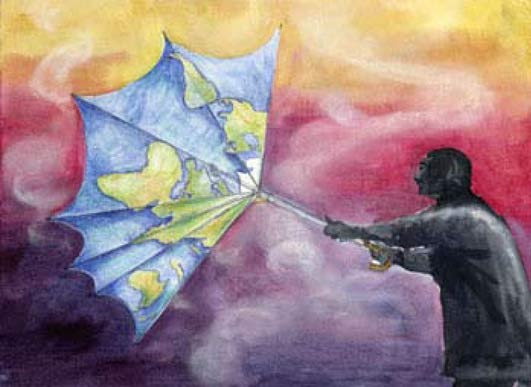 Fog-gray overcast this mid-morning Thursday on California’s north coast, ebbing on through a short-dry period in this way-wet season — next rain forecast for tomorrow afternoon.
Fog-gray overcast this mid-morning Thursday on California’s north coast, ebbing on through a short-dry period in this way-wet season — next rain forecast for tomorrow afternoon.
Supposedly, an early spring this year, but even with a hearty-welcomed arrival of pleasant weather, a heavy caveat.
Although officially the season changes in less than three weeks — Spring Equinox on March 20 at 6:29 AM (EDT) — the environment is already springing into a warm cycle..
(Illustration found here).
Up here there’s a lot of green, from lawns to redwood forests, and a lot of wetness. Today is turning out to be kind of gorgeous, the overhanging fog warming up the air — tonight, though, according to the NWS, reportedly will be cold, even below freezing in some places. On the coast, we’re under a morning Frost Advisory the next couple of days.
In the desire for nice weather, nowadays the beauty carries a price — Dr Jake Weltzin, USGS ecologist and national director of the USA National Phenology Network (Climate News Network): ‘“While these earlier springs might not seem like a big deal and who among us doesn’t appreciate a balmy day or a break in dreary winter weather they pose significant challenges for planning and managing important issues that affect our economy and our society.”‘
Supposedly, spring arrived 22 days early this year in Washington DC, and in Greenland some plants are springing to growth 26 days earlier than it did a decade ago. Studies in the relatively new science of phenology — the calendar record of first bud, first flower, first nesting behaviour and first migrant arrivals — has revealed meteorological fears of global warming as a consequence of the combustion of fossil fuels.
Weltzin, noted above, was part of a new study in Biology Letters, which targeted the northern polar regions.
Further from Climate News Network on the research:
And the most dramatic changes are observed in the high Arctic, the fastest-warming place on the planet, according to a study in Biology Letters.
As the polar sea ice retreats, the growing season gets ever longer — and arrives earlier.
The pattern is not consistent: grey willow sticks to its original timetable, and dwarf birch growth has advanced about five days earlier for each decade.
But the sedge, almost four weeks ahead of its timetable in a decade, holds the record, according to a study that observed one plot at a field site in West Greenland, 150 miles inland, for 12 years.
“When we started studying this, I never would have imagined we’d be talking about a 26-day per decade rate of advance,” says Eric Post, a polar ecologist at the University of California Davis department of wildlife, fish and conservation biology, who has been studying the Arctic for 27 years.
“That’s almost an entire growing season. That’s an eye-opening rate of change.”
In the still wintry US, organizers of the National Cherry Blossom Festival announced yesterday the month-long event will begin March 15, five days earlier than planned. The festival will run through April 16.
Via the Washington Post:
The earliest peak bloom in the city is March 15, recorded in 1990, according to National Park Service records.
In 2014 and 2015, peak bloom occurred April 10 — the latest the city had seen in a decade.
The National Cherry Blossom Festival is considered the world’s largest U.S.-Japanese celebration.
First lady Melania Trump is an honorary chairwoman of the festival, and Japanese ambassador Kenichiro Sasae is involved in planning.
Sasae took a political dip for the occasion: ‘“I don’t need to say ‘Make this Cherry Blossom Festival great again,’ because it’s already great.”‘
Yeah…
In other climate items, more heat in the Arctic –per Reuters: ‘An Argentine research base near the northern tip of the Antarctic peninsula has set a heat record at a balmy 63.5° Fahrenheit (17.5 degrees Celsius), the U.N. weather agency said on Wednesday.’
The hot day was recorded last week.
Meanwhile, Randy Cerveny, an Arizona State University professor of geographical science and urban planning and also serves as the the Rapporteur of Climate and Weather Extremes for the WMO, added this (Forbes): ‘“The temperatures we announced today are the absolute limit to what we have measured in Antarctica…The polar regions of our planet have been termed the ‘canary’ in our global environment…because of their sensitivity to climate changes, sometimes the first influences of changes in our global environment can be seen in the north and south polar regions.”‘
In related resulting shit — via Yahoo News
Ancient ice that makes up a vast part of Canada’s geography is rapidly melting and the result is an increase in landslides along with the release of previously trapped greenhouse gasses into the air.
In a study called Climate-driven thaw of permafrost preserved glacial landscapes, northwestern Canada, which was published in Geology last month, scientists describe a global trend of warming Arctic permafrost that they claim is warming at twice the rate of the rest of the world.
The melting is especially concerning for the northwest region of Canada, where permafrost decay is affecting an area the size of Alabama,
The mapping project’s lead scientist, Steven V. Kokelj, admitted he’s not surprised by the findings.
“Things have really taken off. Climate warming is now making that happen. It’s exactly what we should expect with climate change,” Kokelj told Inside Climate News.
“And the maps that we produced clearly indicated it’s not just a random pattern. We’re sort of connecting dots here for the scientific community.”
And so it goes…